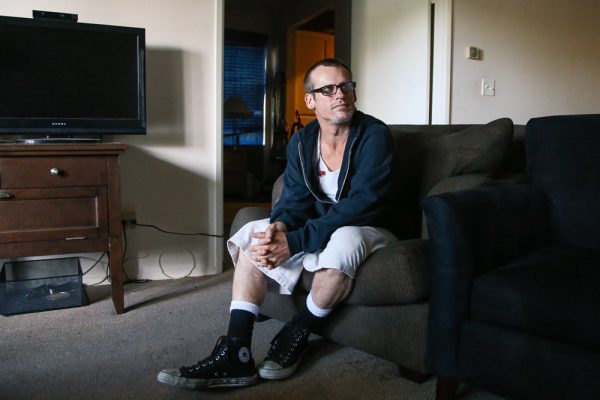Troy Phillips roamed around south Orange County for 11 years, landing on beaches, behind bushes, on a bench, wherever he could for as long as he could until he was asked or forced to “move on.” He came to Laguna Beach often, usually to grab a meal at the city’s overnight shelter in Laguna Canyon.
But he shunned spending a night there. The only year-round overnight shelter in Orange County was too crowded, too volatile, too filled with people who could suddenly turn on him.

“I’ve got a mental illness so sometimes it’s hard to stay in one spot,” said Phillips, now 38, who also bounced in and out of jail over the last decade for criminal charges ranging from substance abuse and robbery to parole violations.
Phillips is diagnosed with paranoid-schizophrenia, conditions that run in his family, said his case worker, Sharon Lee, from the Friendship Shelter, a transitional residential shelter in Laguna Beach. Living on the streets suited him better than a shelter or even a group home, where perceived judgments and threats could easily needle him to react unpredictably, he said.
But since last November, he and 100 other formerly homeless people are staying put, due to a $2.5-million grant from the U.S. Department of Urban and Housing Development and the collaboration of six Orange County social-service agencies. The coalition is determined to solve homelessness by providing the stability of permanent supportive housing, where eligible people find a permanent home and also get local mental health services. Forty-four of the 100 housed homeless came from Laguna Beach.
“There is no credible response to homelessness that does not involve permanent housing,” said Larry Haynes, executive director of Mercy House in Santa Ana. The collaboration won the grant out of 25 other applicants across the country, said Haynes, and also includes the Friendship Shelter, Collette’s Children’s Home in Huntington Beach, Orangewood Children’s Foundation in Santa Ana, Share Our Selves health center in Costa Mesa and Jamboree Housing Corp., a nonprofit in Irvine that builds, acquires and manages affordable housing.
Awarded in January 2015, the grant propelled the process of finding apartments, willing landlords and eligible applicants, placing them in apartments at “fair market” rental subsidies from HUD ranging from $1,161 to $1,324 a month, the group announced last week at Jamboree’s headquarters.
The requirements: chronic homelessness and a debilitating physical or mental disability.
To qualify for an apartment, Phillips took a 17-question survey. The questions reveal two things: “How likely is that person to die on the streets and how expensive is that person to our community in terms of their use of public services,” explained Dawn Price, executive director of the Friendship Shelter, a transitional housing service for adults at 1335 S. Coast Highway. Friendship Shelter has unsuccessfully approached Laguna to build its own permanent supportive-housing for chronically homeless people.
“This isn’t about charity,” said Haynes. “This will save society money. This makes good business sense. It actually costs more to walk past a homeless person than to house them for the rest of their lives.”
The average homeless person costs $100,000 a year in emergency-room services, emergency-response services, police intervention and jail and court costs, explained Billy O’Connell of Collette’s Children’s Home. When they’re housed, the annual costs drop to $20,000, he said.
“We’re housing the most vulnerable first,” Haynes said. “It’s a start. We’ll keep moving up.” A high-risk group that is virtually ignored are homeless women with children, said O’Connell,
The impetus behind the HUD grant is to cut costs to municipalities and taxpayers. It’s renewable after one year if the homeless stay in their apartments and successfully use the supportive services provided, such as health care, both physical and mental, and other social services, said Haynes.
Price and her staff were charged with finding qualified homeless people to apply for the housing. Phillips’s chronic homelessness, mental disorder and jail-time classified him as high risk and an expensive drain on public services.
The majority of the applicants came from Laguna because the Friendship Shelter manages the 45-person shelter formally known as the Alternative Sleeping Location and knows its occupants, which engendered a willingness to take the survey, said Price.
“Sometimes people have been on the streets for so long that housing’s not something that seems tangible or real,” said David Cox, the Friendship Shelter’s permanent-supportive housing program manager explained. “So when it’s offered it seems like a fantasy.”
They’re now living in Laguna Woods, Laguna Hills, Lake Forest, Laguna Niguel, Dana Point and San Clemente. Rents are too high in Laguna Beach to qualify, said Price.
But Phillips didn’t need convincing. “I was like hopeless for a long time,” he said. Living in a one bedroom apartment in south Orange County, following a daily routine of taking his medications, riding his bike or rollerblades for exercise, taking the bus to the food bank or to visit his parents and two sons in Laguna Niguel, and cooking his own meals is freedom, not fantasy, he said.
“I feel at peace,” said Phillips. “I felt like there was always something right there that I can’t stop, I can’t stop because it’s not comfortable. Now it’s mine and nobody will shoo me away because I’m bothering them.” With Lee’s help, Phillips will get a degree, possibly in automotive mechanics, and a job.
Phillips receives $889 a month in Social Security payments due to his disability. One-third of that goes toward rent and health services. Living independently, albeit with financial support, is cheaper in the long run, said Haynes.
The ultimate goal, said Price, is housing a person within 30 days of becoming homeless.





This is how you solve homelessness. Enormous thanks are due Friendship Shelter and the coalition of nonprofits that are keeping people from suffering on our streets. If you wonder what you can do as one person, this is it – write a check to Friendship Shelter, make a meal for their residents, attend their events, give them credit for the strides they are making.
[…] survey garnered agreement that certain things, such as fire and safety measures and housing for the homeless were necessary, and then asked if the voter would be willing to pay for it, Kling […]